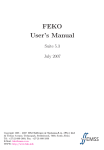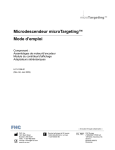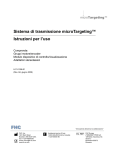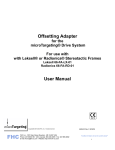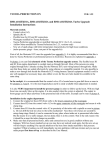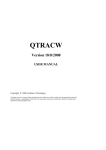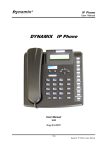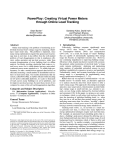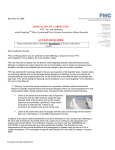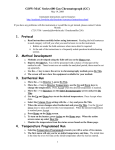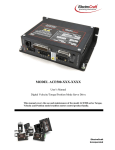Download ICM Manual - FHC, Inc.
Transcript
0 0..1 1E EC CD De ecclla arra attiio on no off C Co on nffo orrm miitty y We: FHC of: Europe (TERMOBIT PROD srl) 129 Barbu Vacarescu Str, Sector 2 Bucharest 020272 Romania declare that: Equipment: ICM Impedance Conditioning Module Model: Catalog No.s 55-70-0 Serial Number: ___________ has been designed and manufactured to the following specifications: IEC61326 Electrical Equipment for Measurement, Control, and Laboratory Uses I hereby declare that the equipment named above has been designed to comply with the relevant sections of the above referenced specifications. The unit complies with all essential Fred requirements of the Directives. 2008.01.16 Signed by: __________________________________Date: ____________________ 09:33:04 Name: Position: Frederick Haer 05'00' President , FHC Done at: FHC Inc., 1201 Main Street, Bowdoin, ME 04287 USA Phone: 1207-666-8190, Fax: 207-666-8292 E-mail: [email protected], Website: http://www.fh-co.com A999.DOC A999 IMPEDANCE CONDITIONING MODULE QUALITY INSPECTION SUMMARY We have made every effort to manufacture this instrument to the highest quality standards. All assemblies have been thoroughly tested and inspected at the factory as follows: Initial Assembly Inspection ________ Initial QC Inspection/Calibration ________ 24 Hour Burn-In ________ Final Performance Inspection ________ Packaging Inspection Initials: __________ Date: __________ Items included with any catalog number may be labeled and packaged separately in shipping carton. Description Checked Cat.#55-70-0 ICM Impedance Conditioning Module Containing: ICM ________ ICM Accessory Kit ________ A999 IMPEDANCE CONDITIONING MODULE Quantity A999 IMPEDANCE CONDITIONING MODULE “Innovation through collaboration” Providing Instrumentation and Apparatus for Cellular Research, Intraoperative Recording, and Microneurography; Micro-electrodes, Micropipettes, and Needles to the Neuroscience Community for 30 years. Impedance Conditioning Module 55-70-0 ICM Impedance Conditioning Module FHC Headquarters 1201 Main Street, Bowdoin, ME, 04287 USA Fax: 207-666-8292 E-mail: [email protected] www.fh-co.com 24 hour technical service +1-207-666-8190 1-800-326-2905(US & Can) FHC Europe (TERMOBIT PROD srl) 129 Barbu Vacarescu Str, Sector 2 Bucharest 020272 Romania L005-18B A999 IMPEDANCE CONDITIONING MODULE A999 IMPEDANCE CONDITIONING MODULE TABLE OF CONTENTS Manual A999: Impedance Conditioning Module 55-70-0 ICM 0 Declarations 0.1 Declaration Of Conformity 0.2 Conditions For Use 0.3 Symbols Used 1 Operational Manual 1.1 Features 1.2 Description 1.3 Operating Environment 1.4 Inventory 1.4.1 Items Described In This Manual 1.4.2 Additional Items Required For Operation 1.4.3 Replacement Items 1.4.4 Optional Accessories 1.4.5 System Configurations 1.5 Concepts 1.5.1 Terminology 1.5.2 Design Description 1.6 Technical Summary 1.6.1 Specifications 1.6.2 Controls / Connectors 1.6.3 Compatibilities 1.7 Illustrative Procedure 2 Reference Manual 2.1 Reference Information 2.1.1 Packaging 2.1.2 Mounting 2.1.3 Inspection 2.1.4 Power Connections 2.1.5 Warranty 2.1.6 Policies 2.1.7 Service 2.2 Installation 2.3 Functional Checkout 2.3.1 Calibration 2.4 Operational Information 2.5 Scheduled Maintenance A999 IMPEDANCE CONDITIONING MODULE A999 IMPEDANCE CONDITIONING MODULE 0.2 CONDITIONS FOR USE Intended Use The Impedance Conditioning Module is used to measure the values of impedance, resistance, and capacitance in microelectrodes. Conditioning modes are intended to fine tune the impedance value of metal microelectrodes. Warnings The Impedance Conditioning Module components should not be disassembled beyond their major assemblies. Any disassembly beyond this may affect function and calibration. If repair is required please contact FHC at (207) 666-8190 for evaluation and to secure a return authorization number if necessary. Storage Precautions Store at normal room temperatures between -34°C (-29°F) and 57°C (135°F). Do not expose to temperatures below -39°C (-29°F) or greater than 70°C (158°F), or a relative humidity of less than 10% or more than 100%, including condensation, or an atmospheric pressure less than 500hPa or greater than 1060hPa for long-term storage. Sterilization None of the Impedance Conditioning Module components are designed for sterilization. Any attempt to sterilize them may result in malfunction or component failure. Handling While a high degree of durability has been designed into the Impedance Conditioning Module components, care should be taken not to drop them. Place all cables and leads where they will not be inadvertently pulled or tangled. 0.3 SYMBOLS USED USB: This symbol is used to designate a standard USB connection. A999.DOC -1- IMPEDANCE CONDITIONING MODULE 1 OPERATIONAL MANUAL 1.1 FEATURES • Fast readout of electrode’s impedance, resistance, or capacitance to two or three digits, depending on range. • A range of adjustable currents and frequencies allows user to perform electrode conditioning. • Provides optional line noise suppression on the measurement signal in noisy environments. • Selectable frequency and voltage/current allow measurement of complex electrode properties, like impedance spectrum, when interfaced to an external computer. • Intuitive knob and pushbutton control of functionality. • All necessary cabling included in accessory kit. • Compact, modular, desktop or rack mountable. 1.2 DESCRIPTION The ICM Impedance Conditioning Module gives the researcher accurate information about the integrity and electrical characteristics of metal microelectrodes. User-selectable readings of impedance, resistance, and capacitance provide a wider range of microelectrode information than has been previously available. The DSP digital signal processor technology executes complex math algorithms, providing accurate readings to two significant digits. Built in adaptive line noise suppression and the driven-shield electrode cable provides seamless isolation from external noise sources and minimize stray capacitance artifacts in the measurement signal path. The line noise suppressor operates in continuous measurement mode and is particularly effective when performing in-vivo impedance measurements. Electrode conditioning by the end user has been built into the ICM. User-adjustable conditioning parameters allow removal of small amounts of insulation from the tip to fine-tune electrode impedances that are found to be a little high. Settings are manipulated through an intuitive pushbutton and adjustment knob interface. All cabling necessary comes in the accessory kit. The ICM is a software-upgradeable device. Its firmware is stored on a FLASH memory that can be re-programmed with the latest code version, available on our support site www.neurocraft.com. 1.3 OPERATING ENVIRONMENT The ICM Impedance Conditioning module components have been designed to operate in a typical laboratory setup. They should be placed on a flat surface that is level and free from contaminants and vibration. If the unit is used for in vivo measurement, a power isolation unit is recommended for safety. A999 - 2 -IMPEDANCE CONDITIONING MODULE 1.4 INVENTORY 1.4.1 ITEMS DESCRIBED IN THIS MANUAL The following Items are included under the following catalog numbers: OR Systems are ordered from the following: 1 ea. Cat. #55-70-0 ICM Impedance Conditioning Module Includes: ICM Impedance Conditioning Module ICM Accessory Kit Includes: Electrode Conditioning Cable Rubber feet (use optional) Calibrated Test Loads User manual (not shown) 1.4.2 ADDITIONAL ITEMS REQUIRED FOR OPERATION The following additional items are ORDERED SEPERATELY: A999 - 3 -IMPEDANCE CONDITIONING MODULE 1 ea. 66-EL-LC-XXX Line Cord (Country specific see sec 2.1.4 of this manual for catalog number) 1.4.3 REPLACEMENT ITEMS Cat. #55-70-0-01 Electrode Conditioning Cable Cat. #55-70-0-02 Calibrated Test Loads 1.4.4 OPTIONAL ACCESSORIES The following accessories are available: 55-11-0 SAF Rack Frame for Stand-Alone Modules A999 - 4 -IMPEDANCE CONDITIONING MODULE 1.4.5 SYSTEM CONFIGURATIONS 1. ICM Impedance Conditioning Module 2. Electrode Conditioning Cable 3. Electrode Holder 4. Microelectrode 5. KCl bath or similar with reference wire 1.5 CONCEPTS 1.5.1 TERMINOLOGY Impedance: In the field of microelectrodes, the impedance value is a reference number that relates to the amount of exposed metal at the tip. The classical definition of impedance as the combination of resistance, inductance and capacitance of an AC circuit is useful in terms of how the microelectrode test circuit is designed, however it is not advisable to focus on within the recording circuit. In broad terms, high impedance produces a more focused recording field that is useful for single unit recording. The trade-off for this is that as the signal is amplified, so is the noise. A low impedance electrode is generally quieter, but records from a wider number of neurons without much inherent selectivity and low amplitude. The impedance value should be looked at as a reference point to duplicate recording situations that have proven to provide reliable data quality. See section 1.5.3 for a wider discussion of impedance. A999 - 5 -IMPEDANCE CONDITIONING MODULE 1.5.2 DESIGN DESCRIPTION The design is based on the APM hardware design, which contains a 32-bit Digital Signal Processor (DSP) allowing complex processing of data. Analog circuitry and signal conditioning is reduced to a minimum, several signal conditioning tasks are being implemented as numerical algorithms that operate on the digitized data. R1 Display V, f R2 Vd R3 AOut R4 Z AIn1 CODEC (ADC/DAC) AIn0 V Electrode DSP Theory of operation Since the data acquisition is driven by a DSP that can perform complex mathematical operations, there’s no real need for a constant current generator that would provide a linear relationship between impedance and output voltage. Instead, a constant voltage generator can be used and the measurement circuit can be a plain voltage divider with the electrode as one branch. In fact, the constant-voltage solution is less sensitive to noise, since the amount of noise picked by the measurement circuit is lower due to the smaller input impedance. The equivalent impedance of a current generator is very large, while the impedance of the circuit shown above is roughly equal to the series resistor (R1 through R4). For illustration purposes, we will first consider a simple circuit where we neglect parasitic resistors and capacitors. Vd Rd V V = Vd Z Z Z + Rd The impedance can be calculated using the following formula: Z = Rd V Vd − V where Vd is the driving voltage of the divider and V is the voltage measured on the electrode. One has to note that by measuring the Vd and V voltages with accurately paired ADC inputs (like the two inputs of a dual/stereo CODEC), no voltage calibration is required for the inputs, since the impedance is calculated as a ratio of two voltages, that is independent of the way they are expressed. Plain numbers A999 - 6 -IMPEDANCE CONDITIONING MODULE resulting from ADC conversion (in the range –32768 to +32767, for a 16 bit conversion) can be used, with no conversion to an actual voltage. In order to minimize the measurement errors, the resistor Rd will need to have a resistance of the same order of magnitude as the electrode. Therefore a number of different resistors (R1 through R4) will be switched using analog switches or relays. In fact, the electrode impedance has both a resistive and capacitive component. The inductive components can be neglected on the frequency range of interest, typically under 10 kHz. Electrodes may have complex models that include several lumped or distributed resistors and capacitors. Regardless of the complexity of the electrode model, at any given frequency, it may be reduced to an equivalent simple circuit containing a resistor and capacitor connected in series or parallel. The choice of the series or parallel representation depends on the frequency and ratio between most salient resistive and capacitive elements, or even on the investigator’s preferences. In many situations, the parallel circuit is the closest representation of the electrode’s more complex model, therefore it will be considered the basis of our representation. Impedance can be represented as a complex number, where the resistive component accounts for the real part and the capacitive reactance for the imaginary part: Ce Rs Z Cs Re 1 1 = + jωCe , Z Re Z = Rs + 1 , jωCs where ω=2πν, and ν is the frequency of the signal. The parallel circuit can be converted to its series equivalent, using the following transformations: Rs = Re 1 , 1 + ω R e2 Ce2 2 ⎞ ⎛ 1 Cs = Ce ⎜⎜1 + 2 2 2 ⎟⎟ ⎝ ω R eC e ⎠ The transformations point to a lower series resistance and a higher series capacitor, compared to the parallel values. When calculating the electrode impedance, one has to compensate for the additional resistances and capacitances in the measurement circuitry. For instance, the electrode leads may have a negligible resistance, compared to the electrode contact resistance, but they definitely have a significant stray capacitance Cs. This capacitance is shunting the electrode signal to ground, particularly at high frequencies. This stray capacitance Cs is included, along with other components that will be described in the next paragraphs, in the equivalent measurement circuit, shown below. Vd Rd V Rin Cshnt Cac Cstray Z The analog circuitry that reads V has an input impedance (composed of a resistor in parallel with a capacitor), whose resistive component Rin can be neglected in most instances (>1015 Ω), while its capacitance can be included in the Cstray value. A999 - 7 -IMPEDANCE CONDITIONING MODULE In addition to that, the resistor in series with the driving voltage has a parallel capacitance, typically in the sub-pF range, but that cannot be neglected in certain instances. In order to have a null net current through the electrode (to prevent electrolytic processes that would etch the tip), an AC-coupling capacitor Cac is inserted in series with the output. Its contribution cannot be neglected at low frequencies for low electrode impedances (<10 kΩ). In order to simplify the calculations that will return the electrode impedance value, we will represent the various resistive and capacitive components as complex impedances, as shown below: Vd V Zd Zac Zs Zd = Where: Z Rd 1 + jω R d C shnt Zs = R in 1 + jω R inC stray Z ac = 1 jω C ac The output voltage will be: V = Vd (( Z + Z ac ) || Z s ) (( Z + Z ac ) || Z s ) + Z d After a series of elementary calculations, one obtains the complex value of the impedance as: Z= 1 − Z ac Vd − V 1 − VZ d Zs One has to note that due to the capacitive component in the electrode and measurement circuitry, the voltage V will have a different phase φ than the driving voltage Vd and can be represented as a complex number: V = V cos( ϕ) + j V sin( ϕ) This phase difference φ can be calculated by measuring the delay τ between the zero-crossing of V relative to the zero-crossing of Vd. ϕ = 360° τ ( in degrees ) T where T is the period of the driving signal (1 ms for a 1000Hz wave). The driving voltage Vd is taken as reference, and will only have a real component. For the simple parallel model, the complex impedance will be: 1 1 = + jωCe , Z Re and the real and imaginary parts of the inverse of the complex impedance will provide us with the following values for Re and Ce : 2 Z Re = Re( Z ) A999 and Ce = − Im( Z) ωZ 2 - 8 -IMPEDANCE CONDITIONING MODULE While the measured voltages V and Vd require no calibration in order to provide an accurate measurement, the other parameters in the impedance formula (Zs , Zd , Zac or rather their underlying Cstray , Rd , Cshnt , Cac) are part of the ICM calibration constants set. However, in order to provide a controlled driving signal, Vd will be calibrated as well in ICM. The driving signal (Vd) is synthesized point-by-point using the CODEC DAC operating at a sample frequency of up to 48 kHz. A table with the points for a single sine-wave period is pre-calculated in a memory area prior to measurement. For instance, for a 1 kHz signal frequency, the table will contain 48 samples. The measurement sequence begins with the generation of the output waveform for about 0.2 seconds, rounded to the nearest integer number of waveform periods. During this interval, no readings of the input waveform are made, the output is allowed to settle to a stationary value. After this interval elapses, the input waveform is continuously digitized with the same rate at which it is synthesized and values are stored in a buffer. In fact, for every cycle of the output waveform, the data is averaged into the same buffer, having a length corresponding to the number of samples for a waveform period. Simultaneously, the driving voltage is digitized and average in the same way, in a separate buffer, to be used as the reference signal. The data is acquired for the user-selected measurement time, rounded to the nearest multiple of the waveform period. When the measurement is complete, ICM calculates the amplitude of the reference and input and the phase difference by performing a complex Fourier transform of the signal at the selected waveform frequency for the reference and input waveforms. The phase angle is calculated based on the ratio between the real and imaginary parts of the Fourier transform. Using the Fourier method for calculating the phase angle proved to be much less sensitive to noise as compared to other methods, like detecting the zero-crossing time. The phase φ, input voltage amplitude |V| and driving voltage amplitude |Vd| are then used in the equations described above for calculating and displaying the impedance Z and the Re and Ce values for the basic parallel equivalent circuit. 1.5.3 A REVIEW OF MICROELECTRODE PROPERTIES When one chooses the measurement parameters, the complex properties of microelectrodes should be kept in mind. The electrode impedance greatly varies with the frequency and amplitude of the measurement signal. For instance, metal microelectrodes are modeled by complex circuits, which can be approximated with a simple parallel or series circuit with a particular resistance and capacitance over a limited frequency range only. Robinson (Robinson, 1968) introduces the equivalent circuit of an electrode, as shown below: Ce en Electrode Tip Rs Rm Cs To Preamplifier Re A999 - 9 -IMPEDANCE CONDITIONING MODULE An abbreviated description of the correspondence between various electrical components and parameters and the physical structures and values would be as follows: en is the potential created by a neuron at the location at the electrode tip; this potential has the value that would be created by the neuron in the absence of the electrode; the electrode may be in fact perturbing the actual potential. Rs is the so called spreading resistance of the saline bath, between the electrode tip and the null isopotential line. Ce is the capacitance of the electric double layer formed around the electrode tip due to electrochemical processes Re is the leakage resistance due to charge carriers crossing the electric double layer Rm is the resistance of the metallic portion of the microelectrode Cs is the accumulated shunt capacitance to ground from the tip to the input of the amplifier. This includes the capacitance of the insulation as well as the capacitance of the wires and connectors leading from the electrode to the preamplifier These parameters should not be considered constant, they depend on many other factors and particularly on the signal frequency. For instance, both the resistance and capacitance of the double layer vary roughly as 1 ω (Gesteland et al, 1959). The double layer capacitance has been estimated to be in most common situations anywhere between 0.18 and 1.0 picofarads per square micrometer of exposed metal tip (pF/µm2) at a frequency of 1 kHz. For a tip of 100 µm2, (typical of an electrode having a few MΩ impedance at 1 kHz) the capacitance would be between 18 pF and 100 pF at 1 kHz, and roughly 3 times larger at 100 Hz. The spreading resistance of the saline bath is a function of the exposed tip area and geometry, and can be anywhere between a few hundred ohms and tens of kΩ. The shunt capacitance of a typical tungsten electrode immersed for a few centimeters in saline can be as high as 200 pF. This corresponds to a shunt impedance of nearly 0.8 MΩ at 1 kHz. For long electrodes, used for reaching deep brain structures, Cs may become particularly important. This shunt impedance places a limit on the usable range of electrode impedances. While some investigators believe that higher electrode series impedance (the sum of Rs, Rm and impedance of parallel group Ce and Re) provides better results, which is true in terms of achieving better isolation of individual neurons, one should keep in mind that this leads to a stronger attenuation of the signal due to the higher electrode/shunt impedance ratio. In other words, in the previous numeric example, it won’t be particularly useful to use electrodes having an impedance much larger than the shunt impedance, i.e. 0.8 MΩ. As a rule of thumb, the electrode series impedance should not exceed twice the shunt impedance, or the signal will be greatly attenuated. It is also important that the electrode impedance is measured in conditions similar to those that will be used during actual recordings, that is immerse the electrodes in saline for the same depth they will be inserted in the tissue or tissue and guide tube. In fact one can measure the electrode impedance with the tip barely making contact with the saline bath, measurement that would give an indication of the electrode series resistance, and another measurement with it immersed into saline for a depth matching the recording conditions, in which case one could figure out what is the contribution of the shunt capacitance. It is advised that the electrode impedance is checked even under real recording conditions, while inserted into the preparation or in-vivo. The measured impedance would not only depend on geometry and recording conditions, but also on the electrical parameters of the measurement, since components in the electrode model discussed above may have non-linear voltammetric or frequency characteristics. Higher measurement currents or voltages generally result in lower impedance readings. Not only that, but higher currents may lead to irreversible morphological and electrochemical properties of the electrode, A999 - 10 -IMPEDANCE CONDITIONING MODULE resulting in a change of the electrode impedance. In general, high measurement currents will cause a permanent drop in the electrode impedance. This effect is the basis of electrode conditioning process, where high AC currents are used to lower the electrode impedance. This is why the ICM factory default on the measurement current or voltage is set to 15% of the full scale, and one should use caution with higher output values. On the other hand, when one applies DC (or very low frequency) signals to the electrode, in most cases electrolytical processes develop at the electrode-electrolyte interface, that may result in both an increase or a decrease of the impedance, depending on the nature of the electrolyte. Passing a DC current through an electrode immersed in Kohlrausch's solution (3% PtCl, 0.025 N HCl, and 0.025% lead acetate) results in the deposition of spongy colloidal layer of platinum that increases the tip area, effectively reducing the tip impedance. On the other hand, passing DC or low-frequency currents through electrodes immersed in many other electrolytes (e.g. saline) results in an increase of the tip impedance, due to the deposition of layers of non-conductive material or even to the electrode tip electrochemical etching, resulting in a reduction of the effective tip area. The impedance of the electrode strongly depends on frequency. The frequency variation of the impedance, using typical values for the model components from Robinson, 1968, is show below: 9 10 Total Series Shunt 8 10 7 Z (Ω ) 10 6 10 5 10 4 10 1 10 2 10 3 10 ν (Hz) 4 10 5 10 The typical frequency variation of the electrode impedance calculated for Rs=50kΩ, Ce=50pF at 1kHz, Re=13300MΩ at 1kHz, Rm=100Ω and Cs=100pF. The series resistance is composed of Rs, Rm, Ce and Re. The shunt impedance is given by Cs. The total electrode impedance, as measured by ICM, is the series electrode resistance, in parallel with the shunt impedance. When measuring the electrode impedance at two different frequencies, for example 100Hz and 1000Hz with the model parameters used in the above figure, one should expect a 5.8 times larger impedance reading at 100Hz compared to the value at 1000Hz. Any direct comparison between the measured electrode impedance in a lab setting and the nominal impedance claimed by the electrode manufacturer must at least take into account the frequency of the signal and, for high impedance electrodes, where the shunt capacitance is significant, the immersion depth. In this latter case, the stray capacitance of the measurement leads may be significant. While the ICM implements guarded shields and digitally compensates for the stray capacitance, any additional wires or connectors may add to the stray capacitance and influence the impedance reading. As the factory measurement conditions may be different from vendor to vendor, any comparison of electrode impedances across vendors must be made taking into account these differences. The phenomena taking place while recording through metal microelectrodes are so complex that Robinson concludes that "description of the elements of A999 - 11 -IMPEDANCE CONDITIONING MODULE microelectrode recording makes it possible to understand, however crudely and approximately, which elements are important, which are unimportant (...). Unfortunately, knowledge of these qualities does not permit one to tell" in detail "how a given electrode will perform in brain tissue". ICM attempts to provide investigators a tool that would give a more accurate indication of various electrode components values, for evaluation and better understanding of the electrode properties and their performance for recording. 1.6 TECHNICAL SUMMARY 1.6.1 SPECIFICATIONS ICM: Measurement Accuracy: +-5% actual. Displayed to 2-3 digits, depending on range. Measurement Applied Voltage: Adjustable 10% - 100% of 1.75Vpp sine wave, Default is 20% Measurement Frequency: Adjustable from 50Hz to 4kHz Impedance Range: 1kΩ to 100MΩ Conditioning Voltage Range: Adjustable 10% - 100% of 3.5Vpp sine wave, Default is 100% Conditioning Current Frequency: Adjustable from 50Hz to 4kHz Display: 8 characters, 1cm height, red Power Requirements: 100-240 VAC, 50-60Hz Dimensions: Height: 13cm (5.22") Width: 10cm (4.20") Length: 25cm (9.75") Weight: 1.48 Kg (3.26 lbs) Mounting Options: Tabletop, 4 rubber feet prevent sliding. Rack mountable with SAF Rack Frame (Cat. #55-11-0 Available separately) Computer Interface: High-speed USB 2.0, backwards full-speed USB 1.1 compatible. (Computer needed for FLASH upgrade only) A999 - 12 -IMPEDANCE CONDITIONING MODULE 1.6.2 CONTROLS/CONNECTORS Display – ICM Front Panel: Value Display: 8 character alphanumeric display of: modes of operation, user menu options, and measured values. Controls - ICM Front Panel: Function: Toggle pushbutton for scrolling through functionality menu (see below for menu hierarchy). Confirm: Toggle pushbutton for confirming selection of functionality menu parameters. Z/R/C: Toggle pushbutton for scrolling through last measurement values for Impedance (Z), Resistance (R), and Capacitance. Value Adjust: Turn knob used to toggle through parameters in the functionality menu (see below for menu hierarchy), and to adjust the value of those parameters. Any change affected by this knob does not become active until the "Confirm" button is pressed. Activate: Green pushbutton for activating the measurement or conditioning cycle. Functionality Menu Hierarchy: Measure Frequency (50-4000Hz) Duration (200 - 20000ms) A999 - 13 -IMPEDANCE CONDITIONING MODULE Range (10k, 100k, 1M, 10M, Auto) Differential (On, Off) Output (10%-100% output voltage) Filter (On, Off) Conditioning Frequency (50-4000Hz) Duration (200 - 20000ms) Range (10k, 100k, 1M, 10M, Auto) Output (10%-100% output voltage) Calibrate ADC (0-100M) DAC (0-100M) Settings Default Save Fact Cal Connections - ICM Front Panel: Electrode: 6 pin DIN socket for interfacing the Electrode Conditioning Cable. A999 - 14 -IMPEDANCE CONDITIONING MODULE Controls - ICM Rear Panel: 0|I: Rocker switch used to activate power. Connections - ICM Rear Panel: Power: 3 prong inlet for interfacing line cord to internal universal power supply. USB: High speed USB 2.0 port for interfacing with a host computer. (Custom applications only) 1.6.3 COMPATIBILITIES The ICM Impedance Conditioning Module will perform measurement and conditioning on microelectrodes offered by other manufacturers. Since the circuitry performing the measurement is likely to be different than that used in the manufacturing of the microelectrodes, a different value may be obtained than provided by the manufacturer. 1.7 ILLUSTRATIVE PROCEDURE Measuring Impedance/Resistance/Capacitance 1. Connect leads: Black – Electrode, Red – Reference, Green – Common ground 2. Lower electrode tip in electrolyte solution approx. 1mm. 3. Press the “Activate” button once. The display will read “Meas…” while processing, and then display the impedance (Z) measurement (default) or the last measurement type used (impedance, equivalent resistance, or equivalent capacitance). 4. Pressing the “Z/R/C” button toggles through the last measured values of impedance Z, resistance, R, or capacitance, C. Conditioning Microelectrodes 1. Set up cable and immerse electrode. 2. Press the “Function” button to display the currently selected function and rotate the “Value Adjust” to toggle through the available functions (Meas., Cond. etc) until “Cond” is displayed. Press “Confirm” to select conditioning mode and adjust its parameters (frequency, duration, output current). The display will switch to “Freq” (frequency), which is the first conditioning parameter. 3. Rotate the “Value Adjust” knob if you want to select a different conditioning parameter. 4. Press “Confirm” to display the current parameter value or change it. To change the current value, turn the “Value Adjust” knob. When done, press “Confirm” to accept the displayed value. For instance, when adjusting the frequency, the ICM with briefly display “Freq Set” and will then go back to the parameter selection menu, displaying “Freq”. To cancel the change, press “Function”. The display will switch back to “Freq”. 5. When back in the parameters selection menu, rotate the “Value Adjust” knob to select a different parameter for the conditioning (duration, output), then use the same procedure as described at previous step for the adjustment of the parameter value. A999 - 15 -IMPEDANCE CONDITIONING MODULE 6. Press the “Activate” button once. The display will read “Cond” while processing, and then will perform an impedance measurement and display the impedance, resistance or capacitance (Z, R or C) depending on the selected display mode. 7. Follow steps 3 – 4 to make any changes to the conditioning settings. 8. Press the “Activate” button to perform further conditioning cycles. 2 REFERENCE MANUAL 2.1 REFERENCE INFORMATION The stand-alone modules of the neuroCraft series instruments are packaged in metal cases, which consist of standard 5.25" high front panels. Front panel widths are specified as Type 2 modules (2.05" actual), Type 4 modules (4.15" actual), and Type 6 modules (6.25" actual) Front panels are mounted on extruded top and bottom panels. Flat side panels slide into slots in the extrusions, and are held in place when the back panel is secured into the extrusion. All modules are 9.75" in depth. A999 - 16 -IMPEDANCE CONDITIONING MODULE Type 2 Module Type 4 Module Type 6 Module 2.1.2 MOUNTING All stand-alone modules are completely encased and can be used without further mounting or hardware. Provided rubber feet may be used to protect surfaces from scratching. However, it may be suitable to group modules, and we have made provision for several configurations. The SAF Rack Frame for Stand-Alone Modules (cat #55-11-0) will hold up to eight Type 2 modules, four Type 4 modules, or two Type 6 modules and 2 ea. Type 2 Dress Panels (cat #55-11-1 use optional), while occupying only 3 rack units (5.25") vertically on a standard 19” instrument rack. Several combinations are available for all of the neuroCraft series stand-alone modules. For example an SAF frame could accommodate 3-Type 2, 1-Type 4, and 1Type 6 within its 16" of horizontal rack space. SAF Rack Frame For Stand-Alone Modules (Shown with a neuroCraft Type 2 Module) Dress Panels for SAF (Ordered Separately): • 55-11-1 Type 2 Dress Panel A999 - 17 -IMPEDANCE CONDITIONING MODULE 2.1.3 INSPECTION FHC Modules are factory checked and calibrated but should be carefully inspected upon receipt, before using, or activating power. If any exterior damage to the shipping carton is noted, the instrument(s) should be inspected for obvious physical damage. The contents of each package should be physically checked against the inventory list (sec. 1.3) to determine shortages or errors in inventory. 2.1.4 POWER CONNECTIONS All of the stand-alone modules in the neuro/craft series are powered by an internal universal power supply that accepts inputs of 85-265VAC, 50-60Hz. An international pattern Line Cord (not shown) is ordered separately, and is specified by country per the catalog number. (See table below for catalog numbers.) 66-EL-LC-AUS 66-EL-LC -CH 66-EL-LC -DAN 66-EL-LC -EURO 66-EL-LC 5-ISR 66-EL-LC 5-ITA 66-EL-LC -JA 66-EL-LC -SAF 66-EL-LC -SWI 66-EL-LC -UK 66-EL-LC -USA Australia China Denmark Europe Israel Italy Japan South Africa Switzerland United Kingdom North America 2.1.5 WARRANTY All FHC products are unconditionally guaranteed against defects in workmanship for one year from date of shipment as long as they have been exposed to normal and proper use. Although the oneyear warranty may have expired, please contact our Service Department before attempting any repairs or alterations. Many of these repairs will still be performed at the factory at no charge to the customer. 2.1.6 POLICIES 1. TECHNICAL SUPPORT: It is our policy to provide our customers with the most comprehensive technical support in the industry. If any questions arise or problems occur, we encourage you to call or write and we promise to promptly and comprehensively respond to your requirements. 2. TRADE-UP POLICY: It is our policy to offer customers trade-up ability as new and/or expanded capabilities for their instruments are announced. In many cases, full credit will be given. In general, we will allow 100% credit for two years and depreciate 20% per year thereafter. Please contact our Marketing Department for information relating to your particular situation. 2.1.7 SERVICE Should service be required, please contact our Service Department for a return authorization number and instructions (207-666-8190). Please have the model and serial number on hand (Both are located A999 - 18 -IMPEDANCE CONDITIONING MODULE on the back panel). Carefully pack the instrument before returning. Please include a note indicating: 1. The model number and purchase date of the instrument 2. The person to contact if questions arise 3. The "symptoms" indicating that repair is necessary If the instrument is not covered by the warranty, a quotation will be forwarded to the sender detailing the repairs necessary and charges, before repair is begun. 2.2 INSTALLATION 1. Attach rubber feet to bottom corners of the ICM if mounting on a desktop. If rack-mounting in the SAF Rack Frame, install the device and tighten the front panel thumbscrew before plugging in any cabling. 2. Plug the line cord into the power outlet on the back panel. 3. Plug the electrode cable into the jack on the front panel. 4. Power up the unit. It will go through a "Wait USB" routine (for applications requiring USB) and then the display will read "Z Check". Unit is now ready for use. 5. Route cable so it can't be inadvertently pulled or tangled, and connect the black pin to the electrode, the red pin to the bath and the green clip to common ground. If using differential mode, connect green clip to reference electrode. 2.3 FUNCTIONAL CHECKOUT Functional Checkout: 1) Measure Mode “Impedance Measurement” – Verify the accuracy of Impedance Measurement by performing the following steps below. a. Selecting Measure Mode - Rotate the “value adjust “ knob for “Measure” menu. Press confirm key to enter menu. b. Configure Range – While in the “Measure” menu rotate the “value adjust” knob for “Range”. Press confirm key to enter “Range” menu. While in the “Range” menu rotate the “value adjust” knob for first range to test. Press confirm key to accept setting. c. A999 Measure Impedance – Place the first resistor to be tested matching the range set in the above step. Record in the table below the value of the resistors Z & R value (the Z & R values are toggled by the “Z/R/C” switch). You will use a precision 1% tol resistors for values of 10K, 100K, 1Meg & 10Meg. Remember to repeat steps “b” & “c” for each range tested. Value / Range 10K 100K 1M 10M Expected Value = +/- 5% Value = +/- 5% Value = +/- 5% Value = +/- 5% Measure Auto Range 10M Expected Value = +/- 5% Measure - 19 -IMPEDANCE CONDITIONING MODULE 2) Measure Mode “Frequency Testing” - This section will include testing of frequency settings. Basically the test is to set the parameter and verify that what we measure with an O-Scope is the same as what we set it to. We will use a 10K resistor for this test. a. Select Measure Mode - Like in step “1” above select the “Measurement” Menu. b. Configure Duration - Set the duration to a longer time to allow for measurement of the frequency. To set the Duration rotate the “value adjust” knob for “Duration” menu. Press the confirm button to select this menu. Rotate the “value adjust” knob for a long duration between 6000ms to 9999ms (enough to perform frequency measurement with your OScope) c. Configure Frequency - Rotate the “value adjust” knob for “Frequency” menu. Press the confirm button to select this menu. Rotate the knob for each of the frequencies to test listed below remember to press the confirm button to accept the new frequency. d. Using an O-Scope measure the signal frequency across a 10K resistor placed between the black & red terminal of the ICM cable. Record the frequency measure for each frequency to test in the table below. repeat steps 2c & 2d for each frequency to measure Frequency to Test Expected Measured 100 Hz +/- 5% 1K Hz +/- 5% 4K Hz +/- 5% 3) Measure Mode “Output Voltage Testing” - This section will include testing of Measure output voltage settings. Basically the test is to set the parameter and verify that what we measure with an O-Scope is the same as what we set it to. We will use a 10K resistor for this test. a. Select Measure Mode - Like in step “1” above select the “Measurement” Menu. b. Configure Output Voltage - Rotate the “value adjust” knob for “Output” menu. Press the confirm button to select this menu. Rotate the knob for each of the Output Voltage to test listed below remember to press the confirm button to accept the new Output Voltage setting. c. Place a 10K resistor between the black & red terminal of the ICM cable. Using an OScope measure the signal output voltage across the resistor with the ground lead of the scope on the red electrode lead and the scope probe to the black electrode lead. Record the output voltage measure for each setting to test in the table below. Output Setting 100% 50% 10% Expected Vpp 1.4 – 1.7 Measured ½ of 100% .1 x 100% 4) Measure Mode “Duration Testing” - This section will include testing of Measure duration settings. Basically the test is to set the parameter and verify that what we measure with an O-Scope is the same as what we set it to. We will use a 10K resistor for this test. a. Select Measure Mode - Like in step “1” above select the “Measurement” Menu. b. Configure Duration setting - Rotate the “value adjust” knob for “Duration” menu. Press the confirm button to select this menu. Rotate the knob for each of the Durations to test listed A999 - 20 -IMPEDANCE CONDITIONING MODULE below remember to press the confirm button to accept the new frequency. c. Measure the time from the start to end of a measurement cycle using the O-Scope. Set the scope to a time base setting to capture the entire time envelope. Duration Setting 4000 ms 2000 ms 1000 ms Expected +/- 25% +/- 25% +/- 25% Measured 5) Condition Mode “Signal Generation Testing” – Verify that the signal frequency, amplitude & duration is different between the Conditioning Mode and Measurement Mode. Note: Condition mode exercises two modes of operation, “conditioning” and “measurement”. Conditioning mode remains until it’s duration time has expired before the ICM enters Measurement mode. Test Method – a. Place a 10K resistor across the leads of the ICM cable. b. Connect an O-Scope across the 10K resistor like that of other measurements mentioned above. c. Select “Condition Mode” from main menu level. Press the confirm button to enter Condition Menu. d. Set the “Condition Mode” parms as Frequency 2K hz, Duration 4000ms, Range 10K, Output 100% e. Set the “Measure Mode” parms as Frequency 1K hz, Duration 2000ms, Range 10K, Output 20% f. Set ICM for “Condition Mode” and with the scope ready for measurements press the ICM’s Activate Button. Did you notices a difference between waveforms between the condition mode and measurement modes? You should have witness a change in the waveform frequency, output voltage amplitude and duration. 6) Condition Mode “Output Voltage Testing” - This section will include testing of Condition output voltage settings. Basically the test is to set the parm and verify that what we measure with an OScope is the same as what we set it to. We will use a 10K resistor for this test. a. Select Condition Mode - Like in step “5c” above select the “Condition” Menu. b. Configure Output Voltage - Rotate the “value adjust” knob for “Output” menu. Press the confirm button to select this menu. Rotate the knob for each of the Output Voltage to test listed below remember to press the confirm button to accept the new frequency. c. Place a 10K resistor between the black & red terminal of the ICM cable. Using an OScope measure the signal output voltage across the resistor with the ground lead of the scope on the red electrode lead and the scope probe to the black electrode lead. Record the output voltage measure for each setting to test in the table below. Output Setting 100% 50% 10% Expected sinewave Vpp 3.00 - 3.6 1.5 – 1.88 300mV – 368mV Measured 7) Misc Parameter Testing - This section will test the remain parameter setting and it’s function. Ability to retain settings in memory. A999 - 21 -IMPEDANCE CONDITIONING MODULE a. Diff Mode – The Differential Mode setting is found in the Measurement Mode menu selection. The Diff Mode allows alternate grounding reference connections. i. By default the Diff Mode is set to “off”. Change this to “on” and press the confirm key. Place a 10K 1% resistor between the red and black leads of the electrode measurement cable. ii. Next while in Measurement Mode press the activate button. You will now see an impedance measurement different than an expected 10K due to the internal removal of ground reference via the relay controlled by Diff Mode. iii. Connect the Ground to the Red lead of the ICM cable with 10K resistor still between the Red and Black lead. Press the activate button and should get an expected 10K measurement. Set the Diff Mode back to “off” setting. Did Diff Mode testing pass? b. Saving Configuration Settings Test - This section will test the retention of parameter setting to NV Flash Ram. All that is required is to set only a few settings to determine that they have been retained. i. Change any parameter setting from within Measure or Cond modes. Remember to press the Confirm button to accept any changes. ii. Select the Settings Menu and press confirm at the Save prompt. iii. Turn off the ICM then back on after 10 sec. iv. Return to the Measure or Cond mode where you made changes and note that your change is still there. Did Saving Configuration Settings pass? 8) Test Complete - You have completed the functional check out of the ICM. Please remember to reset configuration change. A quick method to reset configuration changes is to turn the ICM off for 10 Sec then back on. Note! Configuration changes are saved only if you select “Settings” then save them. For the purpose of functional testing we did not save any of the settings. 2.4 OPERATIONAL INFORMATION Setting Measurement Parameters 1. Press Function button. If the unit was last left in measurement mode, display will read “Measure”. Press Confirm button to access measurement parameters. If a different function is displayed, rotate Value Adjust knob until display reads “Measure”, then press Confirm button to access measurement parameters. 2. Once the Confirm button is pressed, the last parameter viewed will be displayed. Rotate Value Adjust knob to toggle through the parameters (Frequency, Duration, etc). Press the Confirm button to access the setting. 3. Use the Value Adjust knob to dial in the setting, press the Confirm button to apply the new setting. Display will return to the parameter selection menu. 4. Press the Function button once to return to the main display. Measuring Impedance/Resistance/Capacitance 1. Connect leads: Black – Electrode, Red – Reference, Green – Common ground 2. Lower electrode tip in electrolyte solution approx. 1mm. 3. Confirm that unit is in Measurement mode. A "Z", "R", Or "C" will be displayed in the leftmost digit. A999 - 22 -IMPEDANCE CONDITIONING MODULE 4. Press the “Activate” button once. The display will read “Meas…” while processing, and then display the impedance (Z) measurement (default) or the last measurement type used (impedance, resistance, or capacitance). 5. Pressing the “Z/R/C” button toggles through the last measured values of impedance Z, resistance, R, or capacitance, C. If the value is out of range or the measurement is presumed inaccurate, the display will blink. For instance, when reading a 100k impedance on a manually selected the range of 10 MΩ, the measured impedance will still be displayed, and may be close to the actual one, but the display will be blinking to indicate that the range is inappropriate for the measured impedance value, and the accuracy of the measurement may be poor. Setting Conditioning Parameters 1. Press Function button. If the unit was last left in manual condition mode, display will read “Cond”. Press Confirm button to access conditioning parameters. If a different mode is displayed (Measure, Plating, etc), rotate Value Adjust knob until display reads “Cond”, then press Confirm button to access conditioning parameters. 2. Once the Confirm button is pressed, the last parameter viewed will be displayed. Rotate Value Adjust knob to toggle through the parameters (Frequency, Duration, Output). Press the Confirm button to access the setting. 3. Use the Value Adjust knob to dial in the setting, press the Confirm button to apply the new setting. Display will return to the parameter menu. 4. Press the Activate button once to return to the main display or wait 5 seconds. Conditioning Microelectrodes 1. Set up and measure electrode impedance. 2. Press Function button and set the manual conditioning parameters as above. 3. Press the Activate button once. The display will read “Cond” while processing through a condition cycle followed by a measurement cycle, and then display the new impedance (Z) measurement 4. Pressing the “Z/R/C” button toggles through the last measured values of impedance Z, resistance, R, or capacitance, C. indicated by the third display digit. 5. Continue conditioning by repeated pressings of the Activate button. To change the parameters after any cycle press the Function button and continue as described above. Saving Settings 1. Press Function button and rotate the knob until you see “Settings” displayed. 2. Press Confirm. The display will read “Save”. Press Confirm again to select saving the settings, or rotate the knob to select a different subfunction (restoring settings or factory calibration). When save is selected, ICM will prompt the user to confirm saving the current settings as power-up defaults by displaying “Confirm”. Press “Confirm” again to save the settings to the non-volatile memory (NVRAM). All measurement and conditioning-related parameters are saved to NVRAM. To cancel saving, rotate the knob until “Cancel” is displayed and press Confirm, or press Function button. Restoring Settings 1. Press Function button and rotate the knob until you see “Settings” displayed. 2. Press Confirm. The display will read “Save”. Rotate the knob until you see “Defaults” displayed. Press Confirm again to select restoring the settings to their factory defaults. ICM will prompt the user to confirm restoring the current settings to their defaults by displaying “Confirm”. Press “Confirm” again to restore the settings. All measurement and conditioning-related parameters are reset to their factory defaults. The calibration is not reset to its factory default. To cancel saving, rotate the knob until “Cancel” is displayed and press Confirm, or press Function button. A999 - 23 -IMPEDANCE CONDITIONING MODULE Re-calibrating ICM 1. Press Function button and rotate the knob until you see “Measure” displayed. Press confirm to select adjusting measurement parameters 2. Rotate the knob until you see “Range” displayed. Press Confirm to select the measurement range you would like to re-calibrate. Rotate the knob to toggle through the available ranges. Press Confirm when the desired range is displayed. Press Function to exit the measurement menu and go back to the top level menu. 3. Connect a known impedance at the ICM input, then press “Activate” to perform a measurement. 4. Press Function button and rotate the knob until you see “Calibration” displayed. 5. Press Confirm. The display will read “Cal ADC”. Pressing Confirm again will select calibration of the ICM analog-to-digital (ADC) converter and will display the last measured Z/R/C value. Rotate the ValueAdjust knob to change the calibration of the ADC. ICM will re-calculate the Z/R/C value based on the updated ADC calibration and display the result. Rotate the knob until the ICM indication will match the value of the impedance connected at the input. You can press Activate button at any time for performing a new measurement instead of using the last measured values. You can press Confirm again to accept the change and save the value to NVRAM or Function to reject it. Canceling the change will not restore the original value of the calibration constant, you will need to cycle the power to restore the original calibration. Please note that calculated Z/R/C values are dependent not only on one calibration constant, but on all the constants for a particular range. Making the ICM indication match the value by adjusting only one calibration constant at a particular frequency for a particular (resistive or capacitive) load will not guarantee that the ICM will perform a correct measurement at any frequency for all type of loads. The ICM calibration is a multi-step process that is beyond the scope of this manual. Please contact a FHC technical representative if you think ICM requires a re-calibration. 6. When back to the calibration constant selection menu, rotate the Value Adjust knob to select a different calibration constant and repeat the previous step. The list of available calibration constants include: a. ADC – calibrates the analog-to-digital converter ADC, such that the reading of the input voltage V described in the Theory of Operation section is correct. b. Vout – calibrates the output voltage Vd (please refer to the model of the measurement circuitry described in the Theory of Operation section) c. Iout – calibrates the maximum output current, i.e. the current that will pass through Rd when ICM input is shorted. Please note that changing the DAC calibration, described below, will require a re-calibration of Iout. d. AC C – calibrates the AC- coupling capacitor value Cac e. Shnt – calibrates the shunt capacitance Cshnt f. Cap – calibrates the stray capacitance Cs g. Ref – calibrates the reference (Vd) voltage reading Restoring Factory Calibration 1. Press Function button and rotate the knob until you see “Settings” displayed. 2. Press Confirm. The display will read “Save”. Rotate the knob until you see “Fact Cal” displayed. Press Confirm again to select restoring the calibration to its factory defaults. ICM will prompt the user to confirm restoring the factory calibration by displaying “Confirm”. Press “Confirm” again to restore the factory calibration. Measurement and conditioning-related parameters (frequency, duration etc) will not be affected. To cancel restoring, rotate the knob until “Cancel” is displayed and press Confirm, or press Function button. Continuous mode 1. Press Function button and rotate the knob until you see “Meas” or “Cond” displayed. 2. Press Confirm. Rotate the knob until you see “Duration”. Press Confirm again to select adjusting the measurement or conditioning duration and rotate the knob to select measurement duration of less than 200ms. When turning the knob past the minimum 200ms value, “Cont” will be displayed. Press “Confirm” again to select the continuous measurement/conditioning mode. In this mode, the measurement will not have a fixed duration, but will be performed continuously, as long as the A999 - 24 -IMPEDANCE CONDITIONING MODULE Activate button is held down. During the measurement, the Z/R/C value will be continuously updated, until the Activate button is released. In continuous mode, the line noise filter is active. In the fixed duration mode the filter cannot be activated, since it requires a continuous measurement in order to learn a replica of the line noise and subtract it from the signal. Please note that an extended measurement time, particularly when using a high output current, may result in a decrease of the electrode impedance. 2.5 SCHEDULED MAINTENANCE A yearly performance of the Functional Checkout in section 2.3 should be performed to ensure function and calibration. If the unit fails any part of this functional test, contact the FHC Repair Department at (207)666-8190 REFERENCES Robinson, D.A.: The electrical properties of metal microelectrodes. Proc. of the IEEE, 56 Nr. 6, 10651071 (1968) Gesteland, R.C., Howland, B., Lettvin, J.Y., and Pitts, W.H.: Comments on microelectrodes, Proc. IRE, vol. 47, pp. 1856-1862 (1959) A999 - 25 -IMPEDANCE CONDITIONING MODULE

































